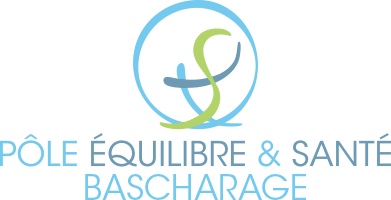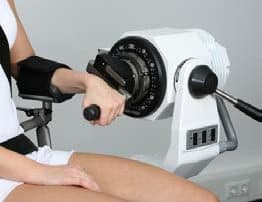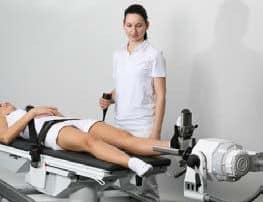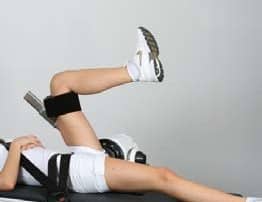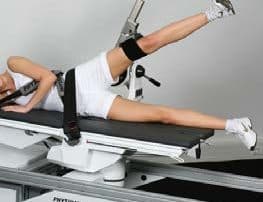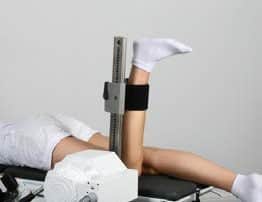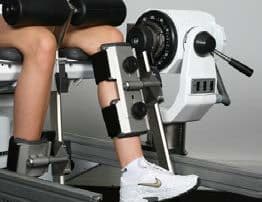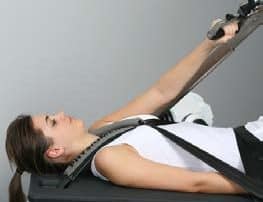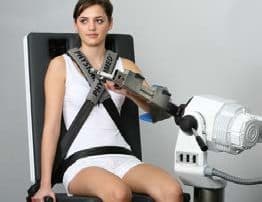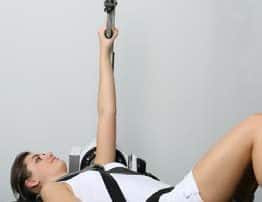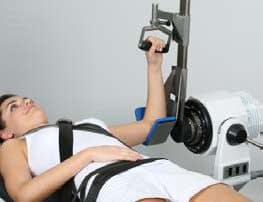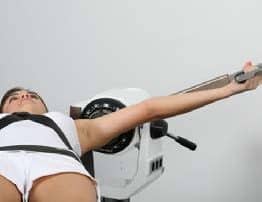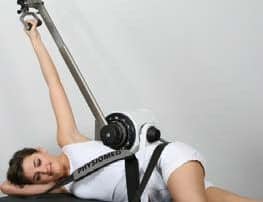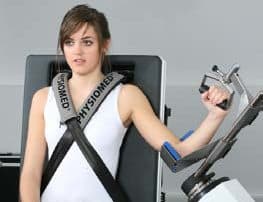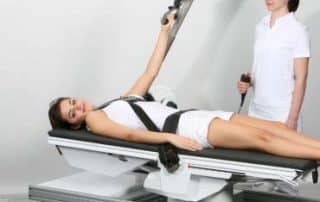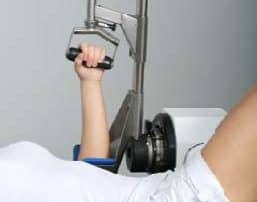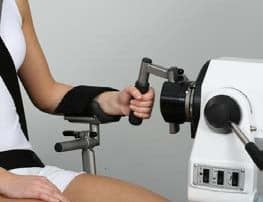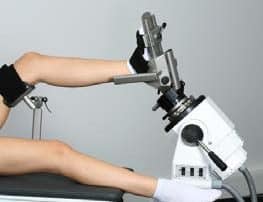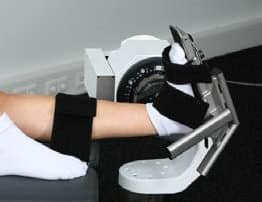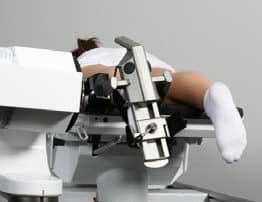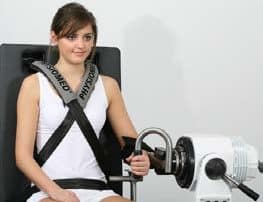Isokinetism

Definition
Isokinetism refers to a mode of dynamic voluntary muscular contraction whose distinctive feature is that it takes place at a constant speed, thanks to self-adapting resistance. This speed regulation is provided by an external device called an “isokinetic dynamometer”. He is so different from work isotonic à load constant and from work isometric or static à length constant.
Isokinetism was developed in 1967 in response to a request from NASA to assess muscle atrophy following weightlessness in space. James PERRINE defines the basis of an isokinetic dynamometer capable of measuring in real time all the variables of movement of a single joint.
Operating principle
The patient acts on a mechanism or receptor. Its action cannot exceed the speed programmed by your physiotherapist. So, as long as the patient remains below the programmed speed, no resistance is encountered. The effort becomes significant as soon as the patient reaches the required speed. The machine’s resistance adapts at all times to the effort required to maintain a constant speed. If, for various reasons (e.g. pain, muscular insufficiency), the effort developed by the patient decreases, the dynamometer resistance is reduced to enable the patient to maintain his working speed. In this way, using a sensor, it becomes possible to know, at any point of the movement, the force developed by the patient.
Description of CON-TREX MJ
The CON-TREX® MJ isokinetic multi-joint system is a versatile testing, training and rotary therapy system for testing and training all major joints, both upper and lower limb, in open kinetic chains. The CON-TREX® MJ dynamometer is the most modular model available, enabling objective, reproducible test results in all working modes. The design of the CON-TREX® MJ is extremely ergonomic: seat position, wheelbase and backrest tilt can be adjusted electronically at the touch of a button. The padded seat and backrest offer maximum comfort, even during long workouts. What’s more, they’re easy to clean and disinfect.
Sitting, lying or standing: CON-TREX® MJ offers maximum adaptability in all situations. It can be used to analyze both the static and dynamic strength of a joint. The resulting functional muscle strength training target is the improvement of coordination skills with possible monitoring and correction during training or therapy.
Thanks to its accessory system, the CON-TREX® MJ allows precise adjustment for each joint, with maximum stability. The adapters are perfectly adjustable to the patient’s anatomical situation.
Depending on the direction of movement, different types of muscle load exist in dynamic modes: concentric/concentric, concentric/eccentric, eccentric/concentric and eccentric/eccentric. Unique to the CON-TREX are the combined load types: CON/CPM, CPM/ COIN, CPM/ECC and ECC/CPM.
Main features
Innovative ballistic control behavior enables higher accelerations and therefore faster movement by pre-calculating the movement to be expected. This results in a significant reduction in the influence of moments of inertia. In ballistic mode, higher movement speeds or a defined speed can be performed isokinetically for longer periods. Ballistic mode optimizes training and testing with realistic, functional movements and loads.
Patients with limited strength are often unable to move individual body segments without assistance. This means that active compensation for these static weight influences is required throughout the entire range of motion. While the movement is being performed, the dynamometer can continuously reduce external forces or even compensate for them completely; this produces a “gravity-free” situation for the patient, where every movement can be performed with minimal expenditure of force.
The extremely high sampling rate of 4000 Hz ensures extremely precise dynamometer control and reduces undesirable effects (temporal frequency deviation in the control system) below the perception threshold. Thanks to backlash-free transmission, no backlash can be felt during reversal of movement, which is particularly relevant for highly dynamic movements (such as throwing). It also allows you to practice unique movement sequences such as the combination of continuous-passive movement (CPM) with concentric or eccentric loading.
Continuously adjustable mechanical movement stops limit the range of movement directly at the dynamometer. In addition, the position of movement stops is tracked by the system and constantly matched to the selected movement pattern. In this way, the software redundantly prevents the movement amplitude from being exceeded.
In CON-TREX® systems, the dynamometer is moved towards the patient. The dynamometer’s flexible head enables precise, very narrow adjustment of the dynamometer’s rotary axis in relation to the joint axis.
Applications
CON-TREX® can be used for early diagnosis and preventive therapy of musculoskeletal injuries in rehabilitation. It is also used in scientific research and performance optimization. CON-TREX® machines are ideally suited to measurement and analysis thanks to their high levels of precision, making them particularly suitable for scientific use. In training and therapy, they aim to improve muscular capacities (in the areas of strength and endurance) as well as sensorimotor skills. Thanks to its versatile measurement capabilities and intuitive exercise software, CON-TREX® is ideally suited to the following applications:
Orthopedic rehabilitation and traumatology :
- Diagnosis and rehabilitation of musculoskeletal deficiencies: Muscle imbalances can disrupt the ideal sequence of movements and can have detrimental effects on joints or, depending on the type of sport, may even be desirable or necessary. CON-TREX® helps to record, detect and analyze these imbalances. CON-TREX® machines can also be used to effectively eliminate muscular imbalances. A particular advantage is that the tested movement can be trained at the same time.
- Prostheses: CON-TREX® machines can be used for rehabilitation after artificial joint replacement. Even with very low muscle strength available, patients can actively train and improve their musculature at a reasonable speed of movement. This means that loss of strength is reduced to a minimum and joint mobility remains the same or is improved.
Neurological rehabilitation :
- When performance is impaired for neurological reasons, for example after a brain injury or stroke, rehabilitation work focuses on re-establishing coordination and control of the work performed by the muscles. The German Neurological Society calls for early functional mobilization of stroke patients. CON-TREX® is suited to this task thanks to its exercise and training function in continuous passive movement mode: the affected patient’s limb is moved by CON-TREX® while the patient can simultaneously attempt to control and move the limb independently. CON-TREX® simultaneously visualizes the patient’s ongoing performance, meaning that training can be followed in real time on the monitor, and even the smallest advance is immediately reproduced on screen. This adds to the patient’s motivation to increase the effectiveness of rehabilitation through active cooperation and biofeedback. This can only be achieved to a limited extent using “classic” training methods. Biofeedback training, particularly with submaximal loading, not only provides effective correction of muscular deficiencies, but is also an excellent method for improving coordination skills.
Performance enhancement :
- CON-TREX® machines are used in top-level sport, especially when it comes to objectively assessing fitness levels and optimizing training progression. Various strength tests that can be performed at regular intervals provide both coaches and athletes with accurate feedback on the effectiveness of their training methods. When rehabilitating top athletes after injury, CON-TREX® machines facilitate training sessions and help reduce downtime.
